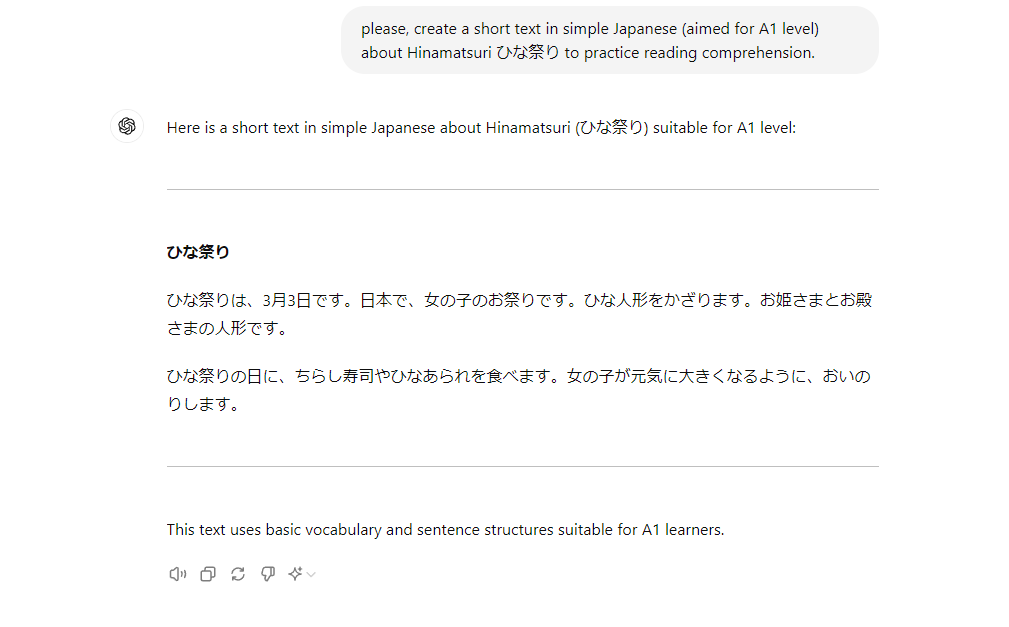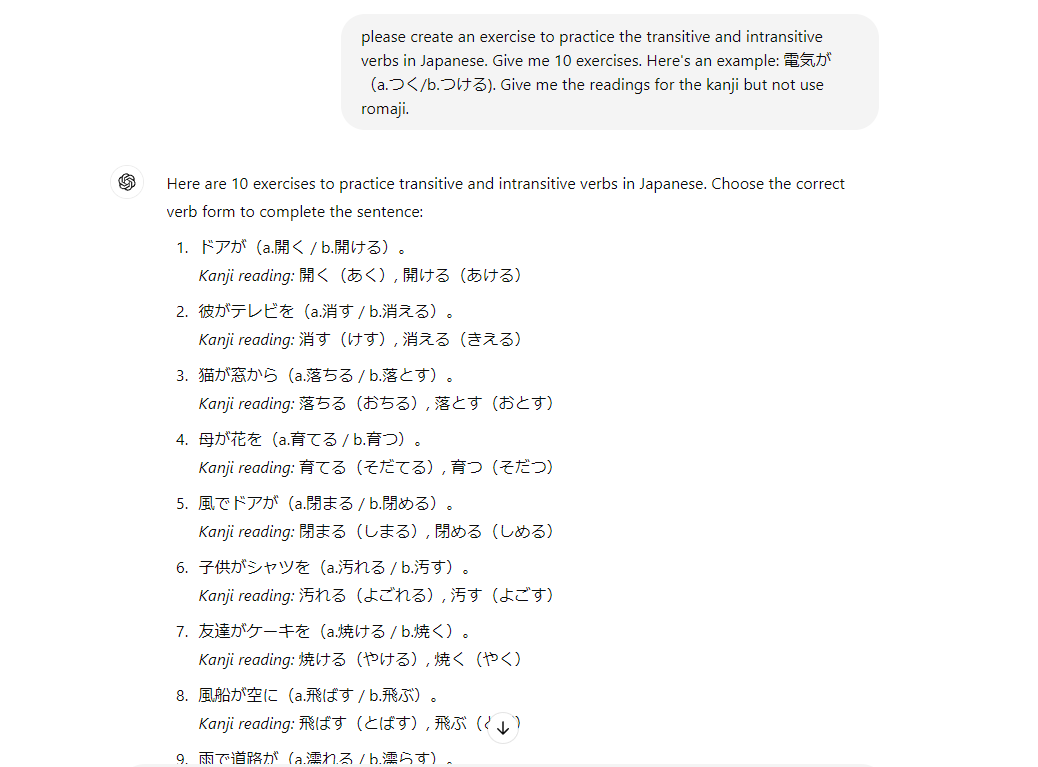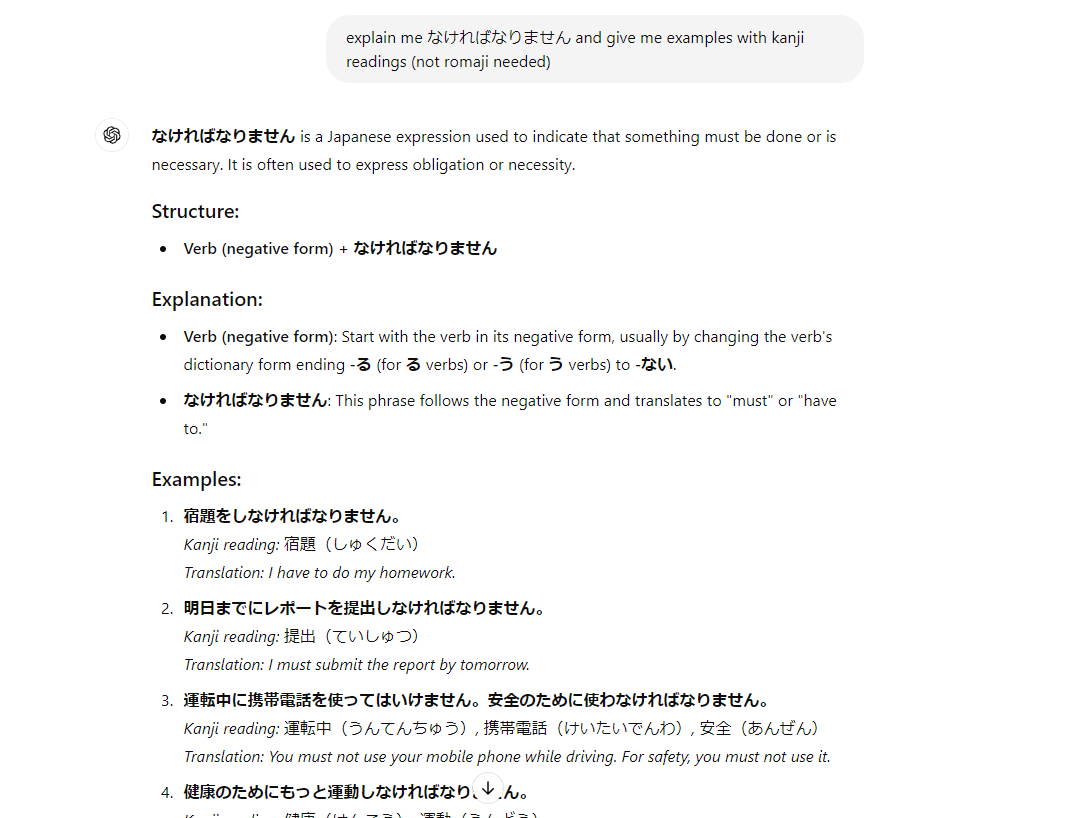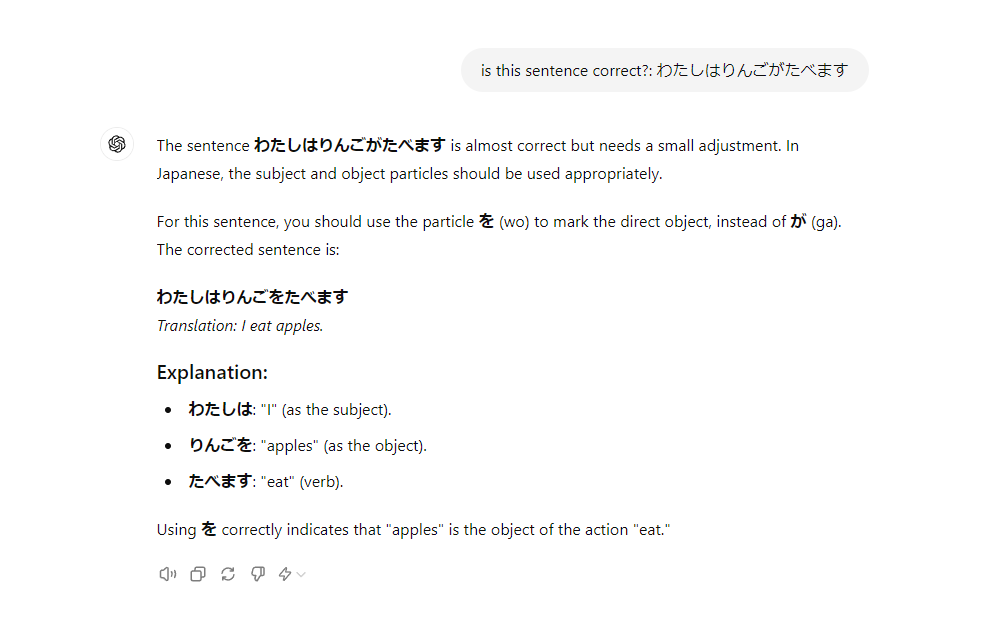Can You Really Learn Japanese with ChatGPT? Here’s What You Need to Know
With over 100 million users since its launch in 2022 by OpenAI, ChatGPT has transformed how people work, study, and communicate—including how we learn languages. As more learners turn to AI for support, a common question arises: Can ChatGPT replace traditional Japanese classes and teachers?
While ChatGPT is a powerful tool that supports Japanese language learning—offering grammar explanations, vocabulary building, and even kanji readings—it doesn’t replace the value of human interaction, cultural understanding, or listening practice. Instead, it’s best used as a complementary tool to enhance your learning experience.
In this article, we’ll explore how to effectively use ChatGPT to study Japanese, highlight its strengths and limitations, and share tips to get the most out of it.

How does ChatGPT work?
Before using ChatGPT to learn Japanese, it’s important to understand how the tool works. ChatGPT is a text-based AI that responds based on the prompts—or instructions—you give it. The quality of your prompt directly affects the quality of the response.
Clear, specific prompts lead to more accurate and helpful answers. Vague input usually results in generic replies that may not suit your learning goals. While ChatGPT doesn’t have long-term memory in free versions, during a session, it can adapt to your preferences and previous inputs.
Think of ChatGPT like a tool you need to “train” through smart prompting. The better your instructions, the more effective it becomes in supporting your Japanese language study.
Chat Gpt Prompts to learn Japanese:
- Make me a list of X Japanese words used in X situation.
- Give me a text in simple Japanese for reading comprehension about X topic. Include these words: X, Y, Z.
- Give me the reading of this Kanji Z and in which context the reading varies.
- Explain me the use of this grammar with simple words and give me examples.
- Tell me if I made mistakes in this sentence.
- Please give me X number of exercises to practice Y grammar with these words: A, B, C, and in multiple choice format (3 options). Don't give me the translations for the words. Here is an example: //////
- Please give me a text in simple Japanese for reading comprehension about shopping in Japan. Include these words: 店 (mise), 値段 (nedan), セール (sēru).
- Explain the difference between 〜が and 〜は in a simple way, with examples.
- Please give me 5 multiple-choice questions about using the polite form (〜ます) with the following verbs: 食べる (taberu), 行く (iku), 見る (miru).
- “Please create a daily conversation scenario in Japanese for me. Let’s pretend I’m at a coffee shop ordering, and you’ll play the barista. After I respond, correct my mistakes.”
- “Give me a list of 10 Japanese phrases for travelers in Japan. Include greetings, asking for directions, ordering food, and other useful situations.”
- “Please create a multiple-choice quiz to test my knowledge of common kanji compounds, like 食事 (shokuji), 学校 (gakkou), etc. Provide explanations for the correct answers.”
- “Give me a short passage in Japanese about a traditional Japanese holiday (e.g., New Year, Tanabata), and include words related to customs. After reading, ask me comprehension questions in Japanese.”
- “Create a conversation in Japanese between two friends making plans for the weekend. I’ll try to respond in Japanese, and you can correct my responses if needed.”
- “Provide me with 5 sentences using the grammar structure 〜たい (want to do), and ask me to rewrite them in different tenses (e.g., past, negative). Correct my mistakes.”
- “Give me an exercise where I need to match the kanji with its meaning and reading. Include common kanji like 日, 月, 山, and 海. Explain any differences in reading.”
- “Please explain the usage of 〜から and 〜ので in simple terms. Then, give me practice sentences where I have to choose between these two based on context.”
- “Create a role-play scenario where I’m a tourist in Japan trying to buy tickets for the subway. Help me by suggesting the right phrases to use in this situation.”
- “Act like a language tutor and help me with shadowing practice. Provide a short audio clip or text in Japanese, and I will repeat it while you check my pronunciation and intonation.”
- “Give me an exercise to practice using the ~ます form and converting it into casual speech (〜る form). Create some daily-use verbs for me to practice.”
- “Create a quiz where I need to choose the correct kanji reading based on the context. Give me sentences where the reading might change depending on the meaning.”
- “Give me a writing exercise where I write a short paragraph introducing myself in Japanese, including details like where I live, what I do, and my hobbies. Then, correct any grammatical errors.”
- “Provide me with common Japanese onomatopoeia (e.g., ぴかぴか, わくわく). Afterward, quiz me on when and how to use them in conversation.”
- “Give me a list of essential verbs used in daily conversations. For each verb, create a sentence example, and ask me to change the verb tense or form (e.g., from affirmative to negative or past tense).”
How do I study Japanese using ChatGPT?
Here are some ways you can use ChatGPT as a tool for learning Japanese.
1) As a English-Japanese/Japanese-English dictionary.
In addition to the dictionaries you use (like Jisho.org) when you don't understand certain word or you need to know how to say something in Japanese.

2) Creating themed word lists.
You can also learn new vocabulary by asking ChatGPT for themed word lists, like, for example, a list of basic greetings, drinks or means of transport.
You also can ask the AI to give you a number of words related to your favorite TV anime or dorama.

3) Hiragana, Katakana and Kanji reader.
There are sites and apps that work as Hiragana, Katakana or Kanji readers, like the Kanji Reader app. ChatGPT can be very useful for learning the kanas if you're a beginner or reading Kanji that you can't read. Just copy and paste the word or words in Kanji and ask ChatGPT to give you the reading. However, you should give details about the context for the right reading because Kanji words may vary in reading and meaning depending on the context.

4) Creating texts for reading comprehension practice.
If you're looking for enhancing your reading skills, then ChatGPT can become a worthy ally. You can give it a prompt saying you want a text about something you like and detailing which words you want the AI to include in it. Also, don't forget to tell it your level of Japanese to avoid ChatGPT giving you a text with complex words.
Another thing you can do with texts is giving ChatGPT a text with words that are hard to understand and telling the AI you want the same text but with simple words. This can also be done by attaching a file containing the text, like a PDF.

5) Creating exersices.
Do you need to practice vocabulary, grammar or reading comprehension? Then you can ask ChatGPT to create exercises for you. Explain the AI how many exercises you want, what kind of words you want to be included, your level and the format of the exercises. For example, a quiz, a cloze, true or false, etc. It's very helpful to give ChatGPT an example of an exercise so it can fully understand what kind of practice you are looking for.
This is quite helpful if you have an exam soon and you need more practice. Give ChatGPT a detailed prompt telling it the topics you need to review and the exercise format for better results.

6) Grammar explanation.
ChatGPT can also explain simple grammar that sometimes isn't explained on textbooks. So, having some grammar notes with example sentences is useful to fully understand the Japanese language.

7) Checking mistakes.
If you wrote a sentence and you don't know if it's correct, you can use ChatGPT for checking mistakes.

Some advice when using ChatGPT.
1) ChatGPT can make mistakes.
ChatGPT can be a wonderful tool for your Japanese study, but it isn't perfect. Sometimes it makes mistakes like a human. It's strongly recommended that you check answers by doing a fast search on Google, checking other resources or asking your teacher or tutor. The AI itself recommends us to do so because it acknowledges there may be mistakes in its answers.
2) Not good for conversation practice.
You may think "Hey, can ChatGPT be my companion to practice conversation in Japanese through chat? That way I won't need a Japanese native or another person who speaks Japanese to practice". It sounds good on paper, but in fact it's not a good idea.
ChatGPT doesn't understand cultural nuances like Japanese has. If you use it to practice conversation, it's limited and it won't have the same result as chatting with a real person. For example, you can't ask the AI how it feels or what is its opinion on certain subject since AI don't have feelings. And Japanese has a lot of phrases and grammar that expresses human emotions with some kind of nuance, like ii desu yo いいですよ (ii desu yo) or すみません. ちょっと...(sumimasen. chotto...)
3) Not good as a teacher.
You may also think that ChatGPT can teach you Japanese and be your teacher, but actually it isn't a very good teacher either.
Of course, the AI knows many things in Japanese and can explain grammar, correct mistakes and give you new vocabulary to study, but think about this: it's a teacher that you need to train to give your good answers. As it is, ChatGPT doesn't know you and a teacher must know his or her students and what's being taught.
Summing Up:
ChatGPT is a powerful tool you can add to your Japanese learning journey. Remember, it’s not meant to replace other resources like apps, dictionaries, or even your teacher, tutor, or Japanese-speaking friends. Instead, think of it as a complementary resource that enhances your studies. By using ChatGPT alongside other tools, you can take your Japanese to the next level. My final tip? Don’t replace anything, but make the most of every learning tool at your disposal. ChatGPT is a fantastic addition to your toolkit!
So now you know how to use ChatGPT for studying Japanese, it's a good idea to start with Lingopie, the language learning platform and app where you can learn by watching real and great TV, like anime and doramas. What's more, you can have private or group lessons with real Japanese teachers. What are you waiting for? Sign up and start your free trial now!
See you!
You may also like:



Frequently Asked Questions (FAQ’s)
1) Can ChatGPT be used in Japan?
Yes, ChatGPT can be used in Japan without any issues. As long as you have internet access, you can use it on your browser or mobile app to assist with tasks like translation, writing, and language learning. It’s a helpful tool for both locals and foreigners living in Japan, especially for studying or working in a bilingual environment.
Can I use AI to learn Japanese?
Absolutely. AI tools like ChatGPT are excellent for learning Japanese, especially for practicing grammar, building vocabulary, and getting instant explanations. You can even use it to have conversations in Japanese or ask for cultural context. For best results, combine AI with other learning methods like textbooks, apps, native speakers, and immersion in real-life situations.
Is ChatGPT good at translating Japanese?
Yes, it works—AI can explain Japanese grammar and teach you new vocabulary. It can also understand prompts in Japanese and reply in Japanese. However, keep in mind that ChatGPT’s training data is mostly in English, not Japanese. This means the AI “thinks” in English, which can lead to a loss of the cultural nuance in Japanese expressions. For that reason, it’s highly recommended to double-check ChatGPT’s answers using other trusted resources.
Can ChatGPT do Furigana?
Yes and no. ChatGPT can provide furigana—the phonetic reading of kanji using hiragana—but it doesn’t format it the same way as Japanese word processors do (like in Microsoft Word or printed materials). Instead of placing the furigana directly above the kanji, ChatGPT typically adds the reading in parentheses right after the character. For example: 食(た)べます. While this isn’t visually identical to standard furigana formatting, it’s still a practical way to show pronunciation in plain text, especially in digital or email formats.
Can ChatGPT help you prepare for the Japanese Language Proficiency Test (JLPT) or Nihongo Nōryokushiken (日本語能力試験)?
Yes, ChatGPT can be a valuable tool for preparing for the JLPT (日本語能力試験). You can use it to practice grammar explanations, generate sample questions similar to those on the exam, review vocabulary, study kanji, and improve reading comprehension. While ChatGPT excels in text-based learning, it cannot provide audio-based listening practice since it operates through written responses. To fully prepare for the JLPT, it’s best to combine ChatGPT with official practice materials and audio resources for listening skills.










![What's The Best Way To Learn Japanese? [Guide]](/blog/content/images/size/w300/2025/04/Best-way-to-learn-Japanese.jpg)
